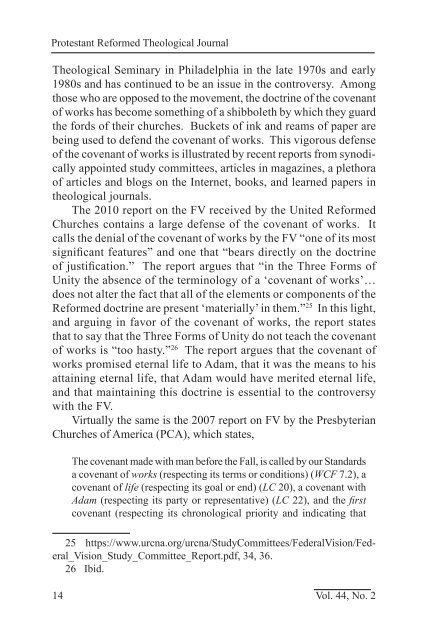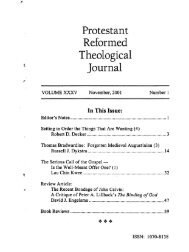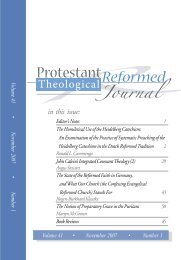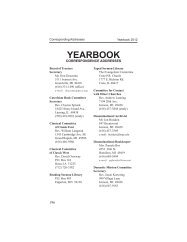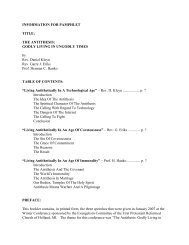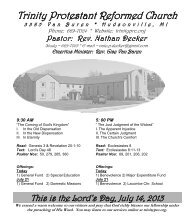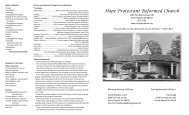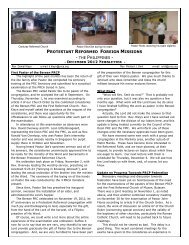A Critique of the Covenant of Works in Contemporary Controversy
A Critique of the Covenant of Works in Contemporary Controversy
A Critique of the Covenant of Works in Contemporary Controversy
You also want an ePaper? Increase the reach of your titles
YUMPU automatically turns print PDFs into web optimized ePapers that Google loves.
Protestant Reformed Theological Journal<br />
Theological Sem<strong>in</strong>ary <strong>in</strong> Philadelphia <strong>in</strong> <strong>the</strong> late 1970s and early<br />
1980s and has cont<strong>in</strong>ued to be an issue <strong>in</strong> <strong>the</strong> controversy. Among<br />
those who are opposed to <strong>the</strong> movement, <strong>the</strong> doctr<strong>in</strong>e <strong>of</strong> <strong>the</strong> covenant<br />
<strong>of</strong> works has become someth<strong>in</strong>g <strong>of</strong> a shibboleth by which <strong>the</strong>y guard<br />
<strong>the</strong> fords <strong>of</strong> <strong>the</strong>ir churches. Buckets <strong>of</strong> <strong>in</strong>k and reams <strong>of</strong> paper are<br />
be<strong>in</strong>g used to defend <strong>the</strong> covenant <strong>of</strong> works. This vigorous defense<br />
<strong>of</strong> <strong>the</strong> covenant <strong>of</strong> works is illustrated by recent reports from synodically<br />
appo<strong>in</strong>ted study committees, articles <strong>in</strong> magaz<strong>in</strong>es, a plethora<br />
<strong>of</strong> articles and blogs on <strong>the</strong> Internet, books, and learned papers <strong>in</strong><br />
<strong>the</strong>ological journals.<br />
The 2010 report on <strong>the</strong> FV received by <strong>the</strong> United Reformed<br />
Churches conta<strong>in</strong>s a large defense <strong>of</strong> <strong>the</strong> covenant <strong>of</strong> works. It<br />
calls <strong>the</strong> denial <strong>of</strong> <strong>the</strong> covenant <strong>of</strong> works by <strong>the</strong> FV “one <strong>of</strong> its most<br />
significant features” and one that “bears directly on <strong>the</strong> doctr<strong>in</strong>e<br />
<strong>of</strong> justification.” The report argues that “<strong>in</strong> <strong>the</strong> Three Forms <strong>of</strong><br />
Unity <strong>the</strong> absence <strong>of</strong> <strong>the</strong> term<strong>in</strong>ology <strong>of</strong> a ‘covenant <strong>of</strong> works’…<br />
does not alter <strong>the</strong> fact that all <strong>of</strong> <strong>the</strong> elements or components <strong>of</strong> <strong>the</strong><br />
Reformed doctr<strong>in</strong>e are present ‘materially’ <strong>in</strong> <strong>the</strong>m.” 25 In this light,<br />
and argu<strong>in</strong>g <strong>in</strong> favor <strong>of</strong> <strong>the</strong> covenant <strong>of</strong> works, <strong>the</strong> report states<br />
that to say that <strong>the</strong> Three Forms <strong>of</strong> Unity do not teach <strong>the</strong> covenant<br />
<strong>of</strong> works is “too hasty.” 26 The report argues that <strong>the</strong> covenant <strong>of</strong><br />
works promised eternal life to Adam, that it was <strong>the</strong> means to his<br />
atta<strong>in</strong><strong>in</strong>g eternal life, that Adam would have merited eternal life,<br />
and that ma<strong>in</strong>ta<strong>in</strong><strong>in</strong>g this doctr<strong>in</strong>e is essential to <strong>the</strong> controversy<br />
with <strong>the</strong> FV.<br />
Virtually <strong>the</strong> same is <strong>the</strong> 2007 report on FV by <strong>the</strong> Presbyterian<br />
Churches <strong>of</strong> America (PCA), which states,<br />
The covenant made with man before <strong>the</strong> Fall, is called by our Standards<br />
a covenant <strong>of</strong> works (respect<strong>in</strong>g its terms or conditions) (WCF 7.2), a<br />
covenant <strong>of</strong> life (respect<strong>in</strong>g its goal or end) (LC 20), a covenant with<br />
Adam (respect<strong>in</strong>g its party or representative) (LC 22), and <strong>the</strong> first<br />
covenant (respect<strong>in</strong>g its chronological priority and <strong>in</strong>dicat<strong>in</strong>g that<br />
25 https://www.urcna.org/urcna/StudyCommittees/FederalVision/Federal_Vision_Study_Committee_Report.pdf,<br />
34, 36.<br />
26 Ibid.<br />
14<br />
Vol. 44, No. 2


